Square Foot Gardening for Programmers
As I've said before, I'm not handy, but I'm trying. I want to also point out that I know exactly ZERO about gardening. All that said, here's what I did this year.
April 10th
This April my wife said it was time for us to have a garden:
One day, last week, it was sunny in Oregon. I looked at the strange yellow ball in the sky and grunted and then I went and bought lumber. I figured this is what people do when it's nice out. I've talked about a garden in the yard for years. This time, I made one.
I got NINE 2x12's, and THREE 4x4's. The first thing I learned was that 4x4s are in fact not four inches square. Turns out the whole inches thing is just a big lie in the wood world. This was news, but now I feel informed. :)
I ordered the dirt/compost, almost broke myself unloading two yards (not sure why it's called yards, but it was a trailer-load and a lot) and last night we planted our vegetables.
I cut the 4x4s into four small two foot posts. I made 1 cut each on 3 eight-foot 2x12s. At this point I had:
- 3 - eight-foot 2x12s
- 6 - four-foot 2x12s
I used wood screws and put them together like this. Make sure you use untreated lumber or "agriculturally treated" lumber. The idea being that you don't want any chemical leaching into the dirt from the wood. We also got weed cloth and covered the ground before I put dirt in the raised beds. This keeps the weeds from coming up from underneath and eating all veggies.
Then I dug 18" holes underneath each of the corners with posts, then flipped the frames over:
I ordered one yard of dirt with compost from a local dirt-person (did I mention I wasn't a farmer? He may have been a Jawa, can't be sure...) and spread it out with a rake.
Next, and this is important, in my opinion, I took some strong yellow nylon string and some nails and separated each bed into 36 one-foot square squares. We planted some seeds but we also found some "organic starters" that were basically little seedlings that had survived the hard part of childhood.
April 25th
Here's two weeks later...it was a little cold at night, sometimes hitting under 36F, so we used weed cloth to actually cover all the beds at night for a about four nights, just to keep them warm. We took the covers off in the morning.
June 25th
Here's two months later. Things are coming along nicely. We were watering for 5 minutes each morning at around 4am, but I was told that was a little too much so we lowered it to 10 minutes three days a week. We didn't use any chemicals.
August 15th
Here's just a few weeks later...things are starting to go crazy. At this point I've realized I've made a few mistakes. The most significant mistake I've made was that I didn't give my tomatoes anything to hold on to. If I did it again, I'd setup little tomato scaffolding and put the tomatoes all against one side of the bed. Interestingly enough, the "All New Square Food Gardening" book warned me of this.
Sept 21th
Here's just a few hours ago at lunch. I've thinned out some of the Zucchini. Here's another thing I learned during this process was this: Only plant stuff you want to eat. I have a metric-ton of Zucchini and one can only eat so much Zucchini bread.
Here's last night's haul. We just went through the garden and picked stuff that looked ready to go.
My conclusion is, gardening is subtle but it's not hard. The amount of effort put in vs. the amount of food you get is minimal. You should try it if you've got even four feet square you can get a non-trivial amount of food.
Related Links
- Paint Fence, Cut Wood, Pull Weed, Plant Tree - Finding Geek Balance Outside My Comfort Zone
- Sharpen the Saw for Developers
- Building your own Arcade Cabinet for Geeks - Part 7 - Success and Conclusion
About Scott
Scott Hanselman is a former professor, former Chief Architect in finance, now speaker, consultant, father, diabetic, and Microsoft employee. He is a failed stand-up comic, a cornrower, and a book author.
About Newsletter
No need to jump on the chemical bandwagon though you just will have to learn to live with it. Year 2 will also require you to give more food.
BTW not sure but aren't zuchini supposed to be like courgettes? And what you have on that picture looks like cucumbers or gurkins, if I got the english names right that is.
And children aren't supposed to play with knives.
Some good advice here on rotating your crops next season, this is because virus and other problems that are associated with a plant family (for example brassicas - cabbage, sprouts etc) can build up in the soil if that plant family are planted in that same spot each season. Also be aware that potatoes and tomatoes suffer with the same fungal infection blight and if it occurs then take out the crop and don't plant either crop in the same spot again. A simple trick for helping reduce problems in your soil is to plant Garlic, this is naturally antiseptic and antifungal, it is long grower (7-8 months) and it's presence seems to help ward off pests and other problems.
You don't have to get supports for beans, peas or tomatoes as you can buy bush types of each of these, that said beans and peas are natural climbers and a simple 8 foot wigwam in the middle of your bed for the beans\peas looks really good and will give you masses of crops.
You can help prevent attacks from pests by covering any members of the brassica family (cabbage, sprouts etc) with horticultral fleech or netting to prevent white butterfly laying eggs and the resulting damage they do. You can also help control other pests such as aphid (greenfly etc) with a few methods, encourage natural predators (more on this in a sec) or if you have an attack control with soft soap spray (non chemical and organic) - for whitefly you can set sticky traps these are also organic controls.
I note you have added some flowers to your beds, these are useful for two reasons, the smell often confuses pests and they encourage pest predators. Research what works best but for example the poachegg plant attracts sawfly whose young love to much greenfly. The plants taglet, calendua and french marigold all confuse whitefly away from tomatoes.
Best if luck with it all
Andy
You can grow potatoes in containers\barrels even old compost sacks if you place several sacks in one to cut out light. I've grown them in a stack of old tyres as well as carrots in old soda bottles and even sweet corn in an old bin. You can buy species of carrots, beetroot, onion and leek that will grow happily in containers and shallow beds.
Andy
Rich - I'm just learning, so it's possible I'll add some more topsoil but as Andy points out I really should maintain the stuff I have. If I puncture the fabric, I'll either put more down or deal with having no fabric. What are your thoughts?
As they are often the native plants of a country weeds are one of natures toughest plants and one of the best at growing, they are spread very easily by wind and rain so although the fabric will stop them coming from the ground they will still come. Just all about weeds you can just dig up however in all cases remove the entire plant, roots and all. If you keep this up on a regular basis then you won't get any build up of weeds and have no need for sprays etc. Don't compost any weeds as you run the risk of the seeds being held in the compost and then spread further.
Another point while I remember is to mulch your beds, again compost is best. Mulch in the winter to stop the rain leeching the nutrients from your beds and in the spring when your plants have established to help trap water. In your part of the world you might need this to help cut down the watering and reduce any water shortage risk (you could also invest in a water butt and drain trap to further help with saving water). Hard to believe in the UK this skill is needed but I've got a lot of experince with working on a site with no water tap.
Andy
One summer I tried to grow corn. I had more corn than I knew what to do with. Then I was passing the supermarket veggy section and noticed just how cheap corn was. I realized the hourly rate of (dimes spent on corn saved ) / (labor) was some absurdly low rate. I haven't grown veggies since.
It sounds like you are having a lot of fun at it ... I just couldn't make the economics work.
Thank you,
Brett Slaski
The size Lumber has changes multiple times, what would that equate to in the .NET world. I guess if a 32bit intiger got smaller over time or some thing of that nature.
A friend of mine was doing a remodel on his house and found that the lumber in his house was not actually true to dimension, but it wasnt the smae size of what he had purchased either.
That rised a problem, How do you nail two pices of wood together that dont touch?
Cheer,
Rick
Zucchini are best when they're small, no more than four inches long. They will grow like mad. I'm pretty sure that they would grow as you watch them. During the peak of the summer, I was checking nightly.
And you know what? Never made zucchini bread with them. Some went to baby food, but most went to zucchini fritters. Delicious and easy. A great way to hide veggies for kids.
Gardening is tremendous fun, for the reason you say: not much effort, not much cost, but a bounty of food.
For your readers here is a link to square foot gardening.
http://www.squarefootgardening.com/
Oddly enough, I was hanging out with a bunch of hippies (of the not-so-crusty variety) yesterday evening at a dinner party that consisted entirely of garden-grown veggies (and local salmon for the omnivores). A few of then run an urban gardening service here in Seattle, and their goal is not just to build gardens but to grow gardeners.
Being a programmer myself, I took a four year break to open a few hostels in Poland, and fell in love with working with physical spaces as an creative outlet that doesn't force me to sit in front of the computer.
Last night's dinner drifted into the usual conversation about pollution, sustainability, and the health problems that emerge from a sedentary lifestyle, and the consensus of the conversation was that more people would love to get away from their computers and televisions and get into activities like gardening, but they're often intimidated, as they have no idea where to begin. And the irony is that gardening is a hell of a lot simpler than software development.
So bravo for digging into your back yard, and thanks for sharing the experience and giving us a little encouragement to try it for ourselves.
Cheers,
Michael
A raised bed has a level of fertile soil that you don't need to dig to create, the bed also drains far better than the ground
A raised bed can have some down sides and the biggest is depth, the ground will have much deeper level of fertile soil and if year on year you double dig the ground the level gets deeper. On sites that have been worked for decades (such as allotments) it is not uncommon to see top soil measured in feet.
Andy
And in colder climates raised beds' soil gets warmer faster in spring so you can plant sooner and harvest sooner.
And of course odl people (like Scott) don't have to bend so deep. All in all a good desiscion.
And of course Compost is your best friend. You can buy it in sacks these days.
Perhaps it's time for a new blog called hanselveggies.
Next thing you know you'll be raising a chickens.
Have fun.
Barry
Andy is pretty close with his reasons,
The raised bed is to:
1 Use a soil "mix" so that your regular dirt does not matter
2 divide the box into easy to manage one foot squares, not conventional rows
3 You never have to turn the soil using the mix that is referred to in the All New Square Food Gardening book, you just add a shovel or two of compost when you are done with the plant(s)
4 Less watering, no weeding
Just go to www.squarefootgardening.com or buy Mel's book.
Scott,
Why did you have someone bring in dirt with your compost? Mel says quite clearly (more clearly than the tomato/vertical concept) what goes in the box. Looks like a pretty sweet garden tho!
As for going deep, 6" is all you need, think build up, don't dig down!
Comments are closed.
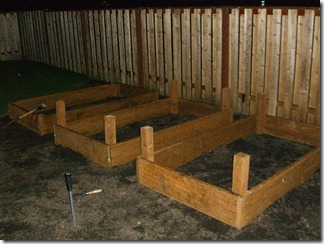
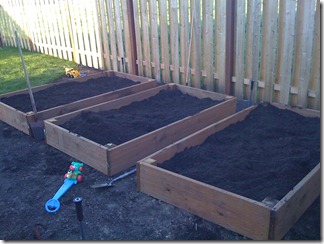
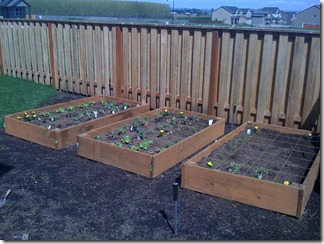
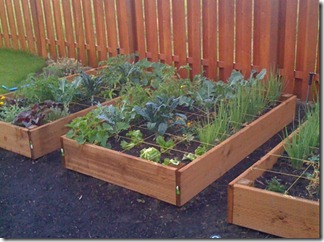

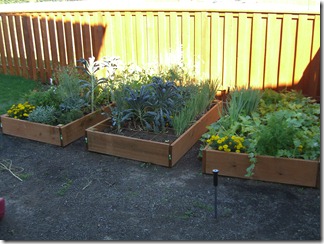
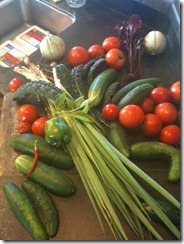
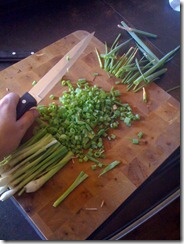

Yes, for tomatoes, peas and some beans you need something for them to climb on and support them. We have two tomato plants this year and so far I've frozen more than a gallon of marinara sauce for pasta this fall and winter.
You might also put in some Blue berry bushes, they do well in your area.
Happy harvesting!